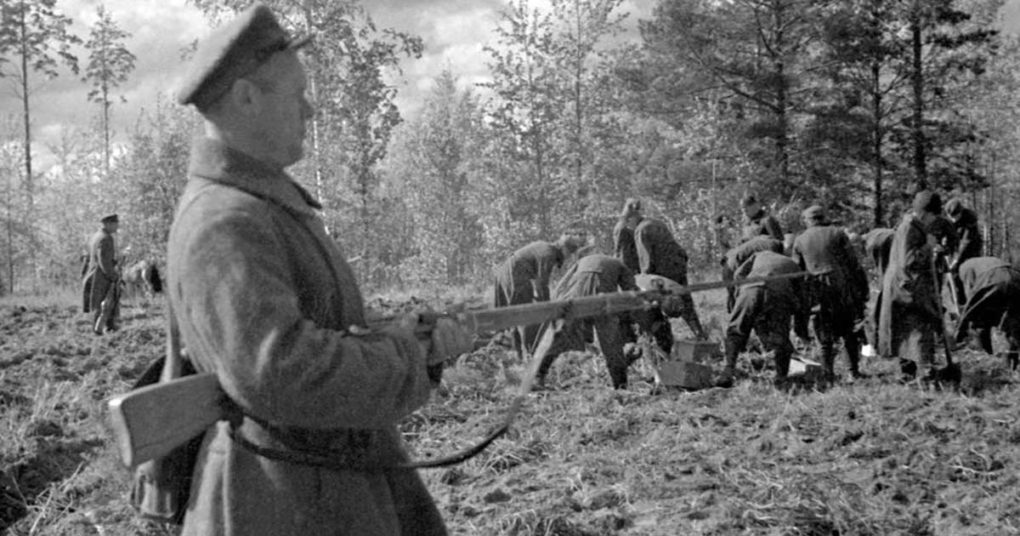This year will mark the 80th anniversary of one of the worst crimes of World War II: the murder of an estimated 22,000 Polish officers and intellectuals by the Soviet secret police in Katyn Forest in Russia in 1940. A recent bout of flu gave me an unexpected opportunity to view the DVD of Katyn, the film made in 2007 about this subject in Polish, though with English sub-titles.
The film’s director, Andrzej Wajda (1926-2016), was a world-famous Polish director, whose films included Danton, Man of Iron, Ashes and Diamonds and Man of Hope, a biopic about Lech Walesa, the founder of Solidarity. Wajda’s father was one of those murdered in Katyn in 1940 so a film on this tragedy was long on his mind.
In Communist times, Wajda stated in an interview accompanying the DVD, it would not have been possible to show a film about Katyn so he didn’t think about it during that period. Post-Communism, however, he prepared for a long time to make the film and it took many years of planning before it was finally completed in 2007. It was filming on an epic scale with 7,000 extras involved as well as leading Polish actors and actresses. The film is told from the point of view both of the officers in captivity and of the anguished women and families left behind and without news of the fate of their loved ones. In the DVD interview, Wajda states that his own mother never really recovered from the death of his father in Katyn.
Katyn, Wajda suggested in this interview, had two aspects: the crime and the lie. What actually happened and what was said about it afterwards. For years, the Soviet Union denied responsibility for the crime and tried to blame it on the Nazis. In recent decades, the facts about Soviet secret police responsibility have become established and were acknowledged by the reforming Soviet leader, Mikhail Gorbachev, in 1990. In 2010, there was further tragedy when a Polish Government delegation, including the Polish President, died in an air crash near Katyn, while on their way to a commemoration ceremony there.
There are many extraordinary moments in the film, which is enriched by the haunting music of the Polish composer, Krzysztof Penderecki. In the opening scenes in Poland in September 1939, terrified crowds fleeing Nazi invasion from one side meet equally terrified crowds fleeing Soviet invasion from the other side. There is later a heart-breaking encounter between a captured Polish officer and his wife in a transit area. She pleads with him to flee captivity for her sake and that of their young daughter but he tells her that he can’t renounce his military pledges.
Another grave moment is the mass arrest in 1939 by German SS troops of academics from the Jagiellonian University in Krakow. In other powerful scenes, an officer, who is being held captive by the Soviets and is in anguish, receives comfort from a comrade’s gift of rosary beads. There is later an address of great nobility on Christmas Eve from a Polish general to his fellow captives and he concludes by leading his men in a beautiful Christmas hymn. Then, there are the harrowing final scenes when something of the slaughter that took place is shown in all its horror as officers are led, one by one, to their deaths and only realise at the last moment what is in store for them.
Though focusing on just one terrible episode, the film is a reminder of the carnage of two world wars and the terrible suffering that accompanied that carnage. It reminds us of the huge personal, family and social losses that occurred. After the war, those who survived struggled to know how best to adapt to life in the post-war Polish People’s Republic. Wajda himself in his interview raises the question of whether there might have been a more effective earlier resistance to post-war Stalinism in Poland if the officers and leaders murdered in Katyn had survived.
And yet the film also points to the constant possibility of re-generation, even in the toughest circumstances and in the face of great evil. Thousands of officers were murdered in Katyn and the facts about the massacre were covered up for many years but the memory of those who died was kept alive by relatives and friends and their story was eventually told, not least through this film. Catholic Poland did manage to resist, albeit in a context of great suffering, both the Nazis and the Communists. In 1978, a son of Poland came to the See of Peter and, in the 1980s, the peaceful Solidarity movement, supported by that Polish Pope, caught the world’s imagination. In 1989, Poland, which had effectively been wiped from the map in 1939 by Hitler and Stalin, emerged again as a free nation.
*Katyn, Artificial Eye, DVD, 2007. Director: Andrzej Wajda (Fit for viewing by persons aged 15 or more).
About the Author: Tim O’Sullivan
Tim O’Sullivan has degrees in history and social policy and taught healthcare policy at third level. He is a regular contributor to Position Papers.

